Your windows are one of the most important features in your home.
Not only do they let in natural light, but they also serve as a focal point and help frame your views.
Choosing the right window treatments can completely transform the look and feel of a room.
Curtains are a simple yet impactful way to dress up your windows.
With so many styles, colors, fabrics and textures to choose from, the possibilities are endless!
Drapery can set the tone for your room’s style, add privacy, and control light filtering.
Now let’s focus on for inspiring photos and detailed descriptions of each idea.
✨Click to Get My 101 FREE Designer Room Ideas
Statement Patterns
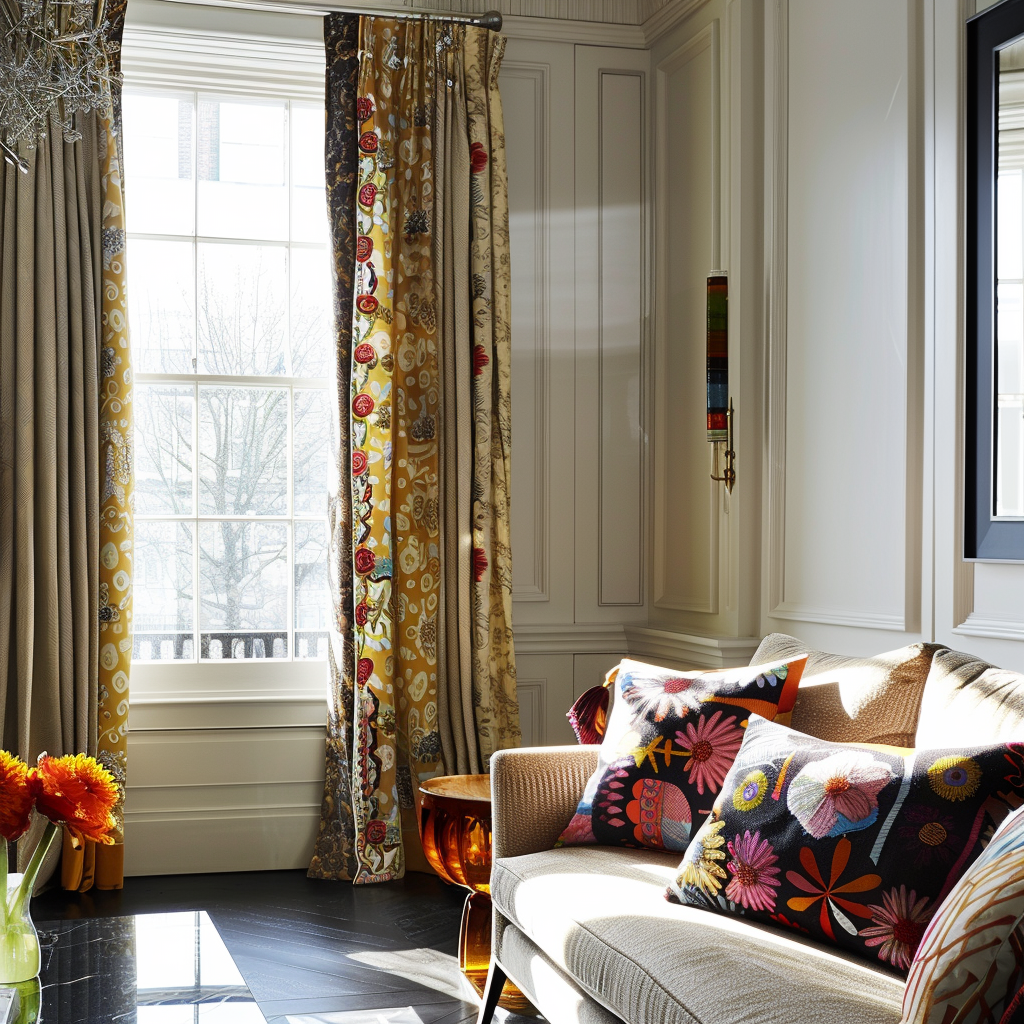
Don’t be afraid to make a bold statement with your curtains!
Choose a vibrant print or exotic pattern to immediately draw attention to your windows.
The contrast of the dynamic pattern against your wall color will make the curtains pop.
Some popular statement pattern options include graphic ikat or suzani prints, vibrant florals, exotic paisleys, vibrant striped designs, bold geometrics, and abstract prints.
Choose patterns with saturated, rich colors for maximum impact.
When selecting a statement pattern, opt for curtains made from soft, luxurious fabrics like silk, velvet, or high-quality cotton.
Limit patterns to one or two so they don’t compete.
Hang patterned curtains high and wide to maximize the window space that the prints cover.
Add patterned toss pillows that complement the curtains.
Vibrant patterned curtains are ideal for living rooms, bedrooms, and playrooms.
Make your windows the focal point of the room with eye-catching prints and colors.
The bold curtains will instantly liven up your space.
Vivid Colors

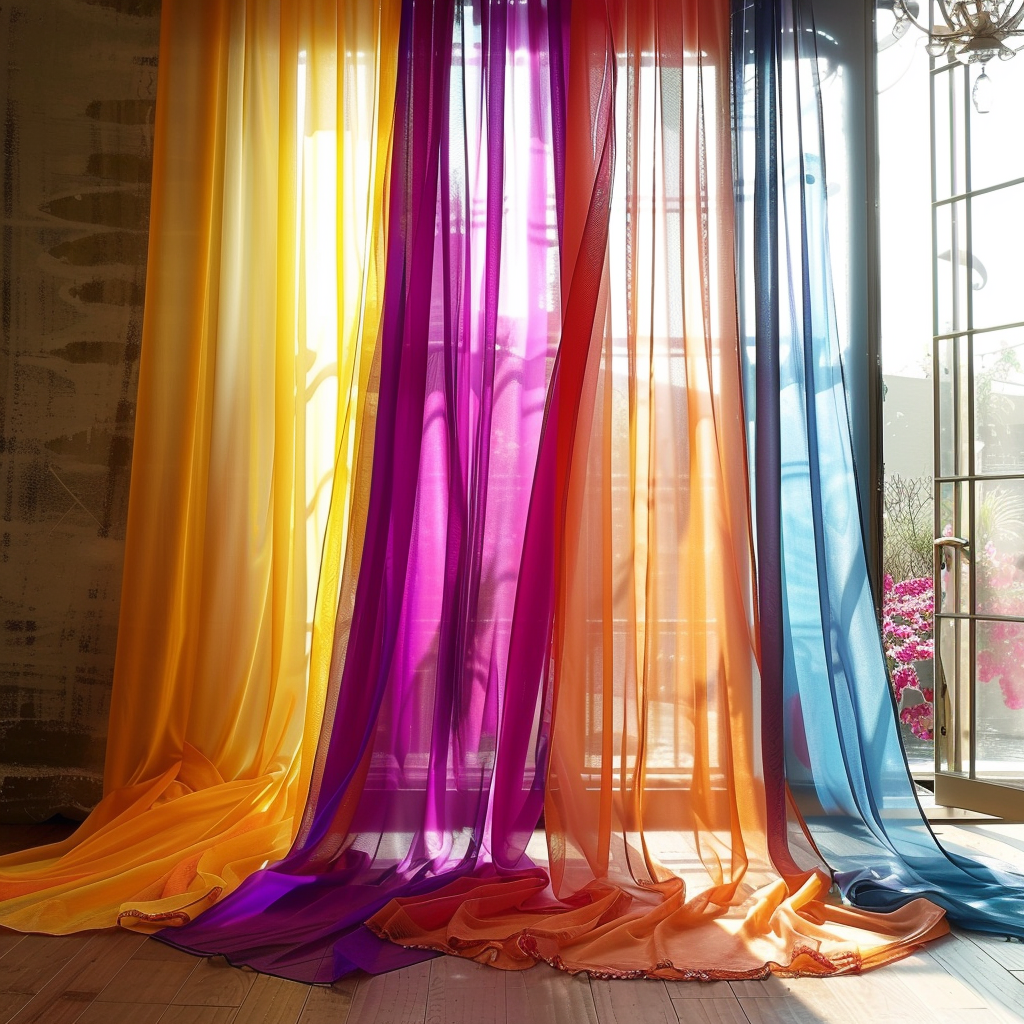
Saturated, vibrant curtain colors are a simple way to make your windows pop.
Choose vivid hues like emerald, sapphire, magenta, mustard and teal to add an energetic boost to your room.
Select richly colored curtains in smooth, luxurious fabrics like velvet, silk or satin.
For a more relaxed vibe, use brightly colored cotton, linen or textured fabrics.
Here are some vibrant curtain colors that make a statement:
- Deep purple – Makes a regal and elegant statement.
Goes well with metallics and velvets.
- Vibrant emerald green – Fresh and invigorating.
Complements earth tones.
- Sapphire blue – Calming and serene.
Works well in bedrooms.
- Sunny yellow – Cheerful and upbeat.
Great for kitchens or sun rooms.
- Brick red – Warm and cozy for living spaces.
Accent with metallic sheens.
- Mustard – Modern and trendy.
Use with neutrals and wood tones.
- Fuchsia – Playful and feminine.
Use in girls’ rooms or bathrooms.
Maximize the impact by hanging floor-length curtains.
Add woven natural fiber rugs and curtain trims in coordinating colors.
Vibrant curtains make the view outside your window even more appealing.
Sheer & Silky

For an airy, ethereal look try hanging sheer curtains made from finely woven translucent fabrics like silk, linen or polyester.
Light filters softly through the gauzy material creating a diffused lighting effect.
Sheer curtains made from textured fabrics like silk add a touch of luxury.
Hang them alone or layered over another set of opaque curtains.
Choose from subtly colored sheers or add visual interest with embroidered detailing, delicate scalloped hems or textured weaves like ribbed or herringbone.
Some popular types of curtains to create this look include:
- Silk organza – Lightweight and crispy sheer made from silk.
Diffuses light beautifully.
- Faux silk – Affordable alternative with a silky drape.
- Linen – Natural fiber with gorgeous drape.
Provides privacy while still allowing light through.
- Sheer voile- Lightweight and airy with excellent light filtration.
No lining needed.
- Lace – Romantic and feminine.
Provides privacy while maintaining an open feel.
Use clipped back curtains during the day to let light flood in.
At night, release the clips for a cozier feel and added privacy.
Sheer silky curtains impart ethereal style and a soft elegance to bedrooms, living rooms or French doors.
Blackout Curtains
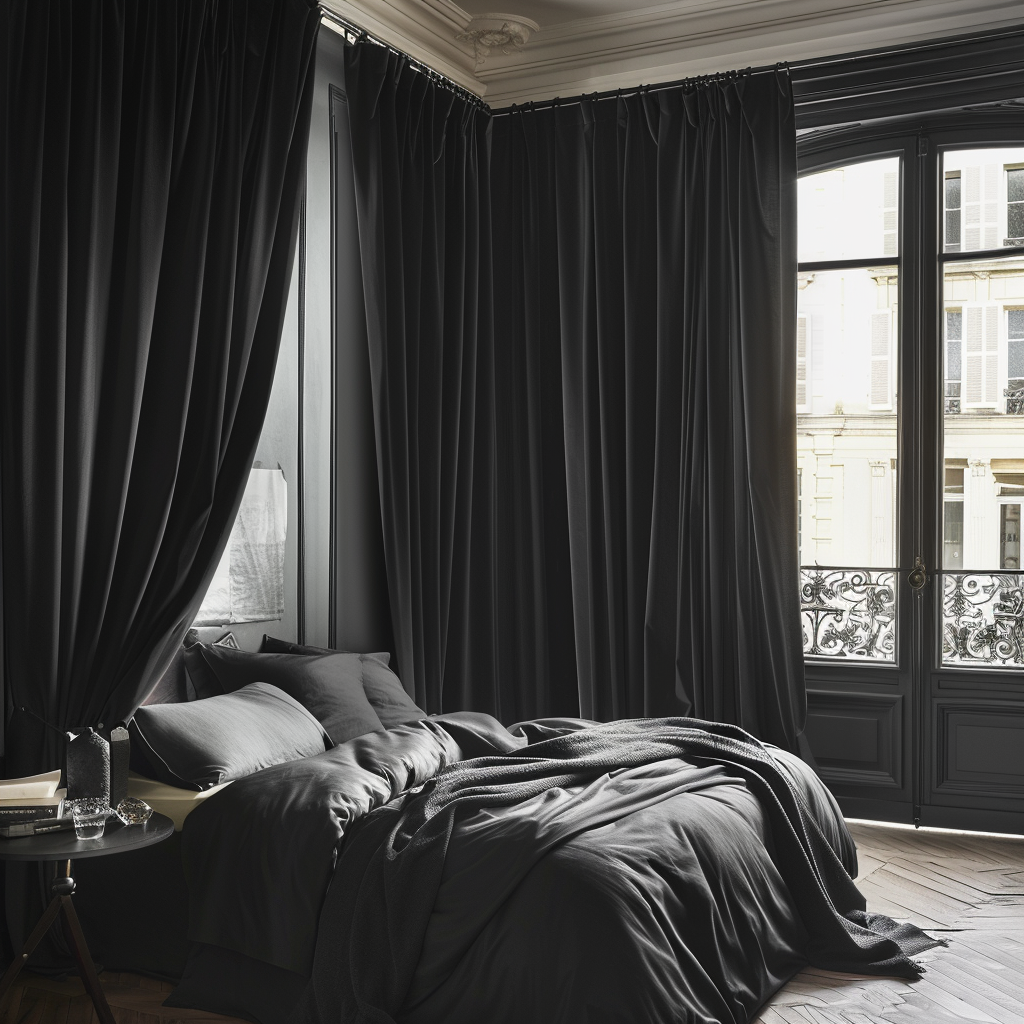
For bedrooms, nurseries and home theater rooms, consider blackout curtains.
As the name suggests, these curtains block out incoming light completely for undisturbed sleep and privacy.
Blackout curtains are made from tightly-woven, opaque fabrics or are created using a special backing that prevents light infiltration.
Either method will block light effectively.
Here are some things to consider when shopping for blackout draperies:
- Coating or layers – Look for blackout curtains with thick opaque coatings or multiple fabric backings to prevent light seepage.
Side hems and edges should fit snugly against windows.
- Hidden compartments – Curtains with built-in pockets or compartments hold weighted magnets or rods to seal off light.
- Thermal properties – For energy efficiency, select curtains with insulating fabrics that reduce heat/cold transfer.
- Lining – Unlined curtains allow some light infiltration.
Opt for blackout drapes with integrated lining for maximum darkness.
- Fit – Curtains should be well-fitted to the window size to limit gaps where light can enter.
Blackout curtain fabrics include polyester, nylon, cotton, faux silk, velvet and heavy damasks or tapestries.
Hang them high and wide to cover the window area completely.
Now you can sleep soundly knowing your room will stay dark all day long.
✨Click to Get My 101 FREE Designer Room Ideas
Textured Materials
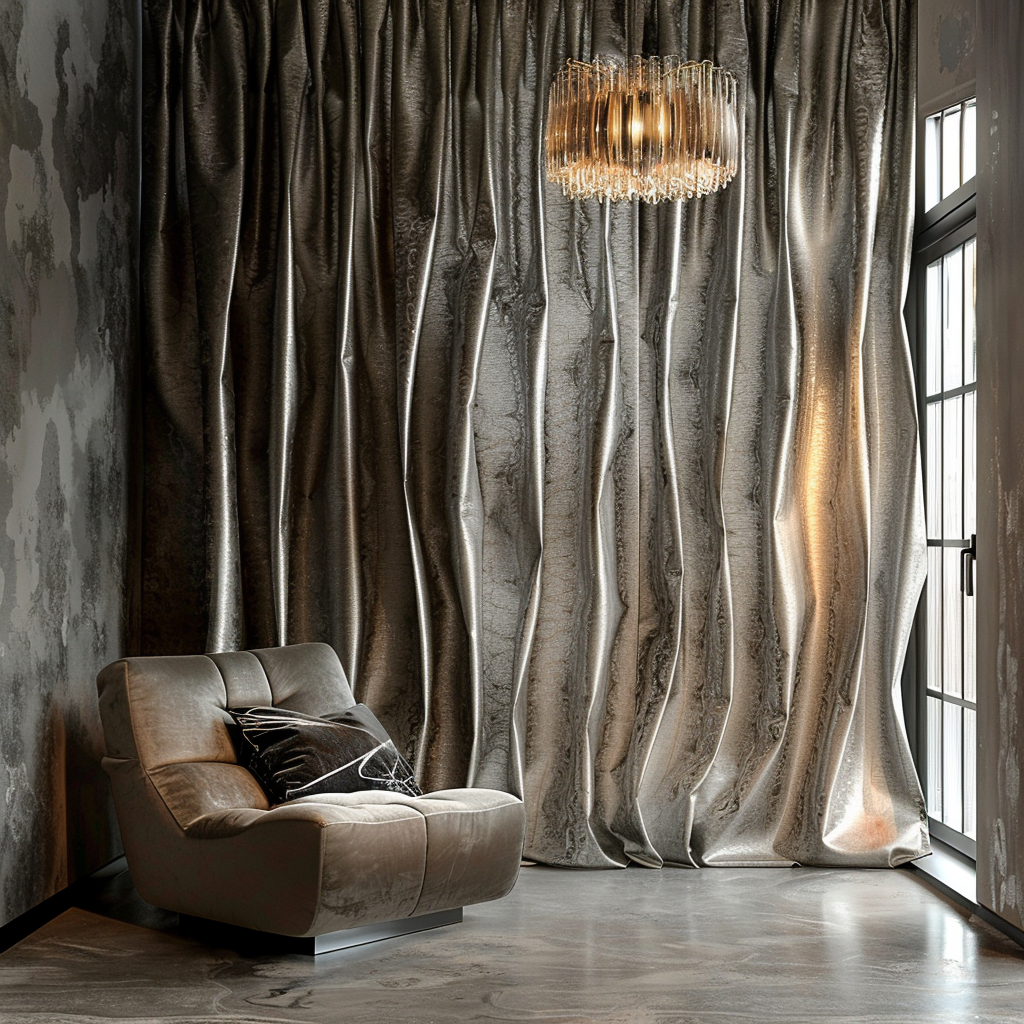
Linens, velvets, silks and embroidered fabrics impart gorgeous visual and tactile texture to curtains.
Choose textured curtains to add depth, sophistication and luxury to a space.
Here are some textured fabrics that provide beautiful drape and detail:
- Linen – Made from natural flax fibers, linen has thickness and knots that provide visual interest.
Available in a range of weights and weaves.
- Velvet – Lush, plush and indulgent.
Gorgeous draping properties and light absorption.
- Faux silk – Affordable alternative to natural silk with beautiful irregularities in the weave.
- Burlap – Natural jute texture creates rustic, casual style.
Use in farmhouse decor.
- Cotton/linen blends – Natural plant fibers that drape beautifully.
The textures blend together.
- Embroidered – Metallic embroidery, ornate floral stitching and applique details add lavish texture.
- Fringe, tassels & trim – Add multiple layers of texture with trimmings along curtain edges.
Iron textured fabrics lightly before hanging to achieve crisp pleats and elegant shaping.
Hang rod pocket curtains high and wide to showcase the fabrics properly.
Textured window treatments create depth and compelling visual interest.
Metallic Sheen
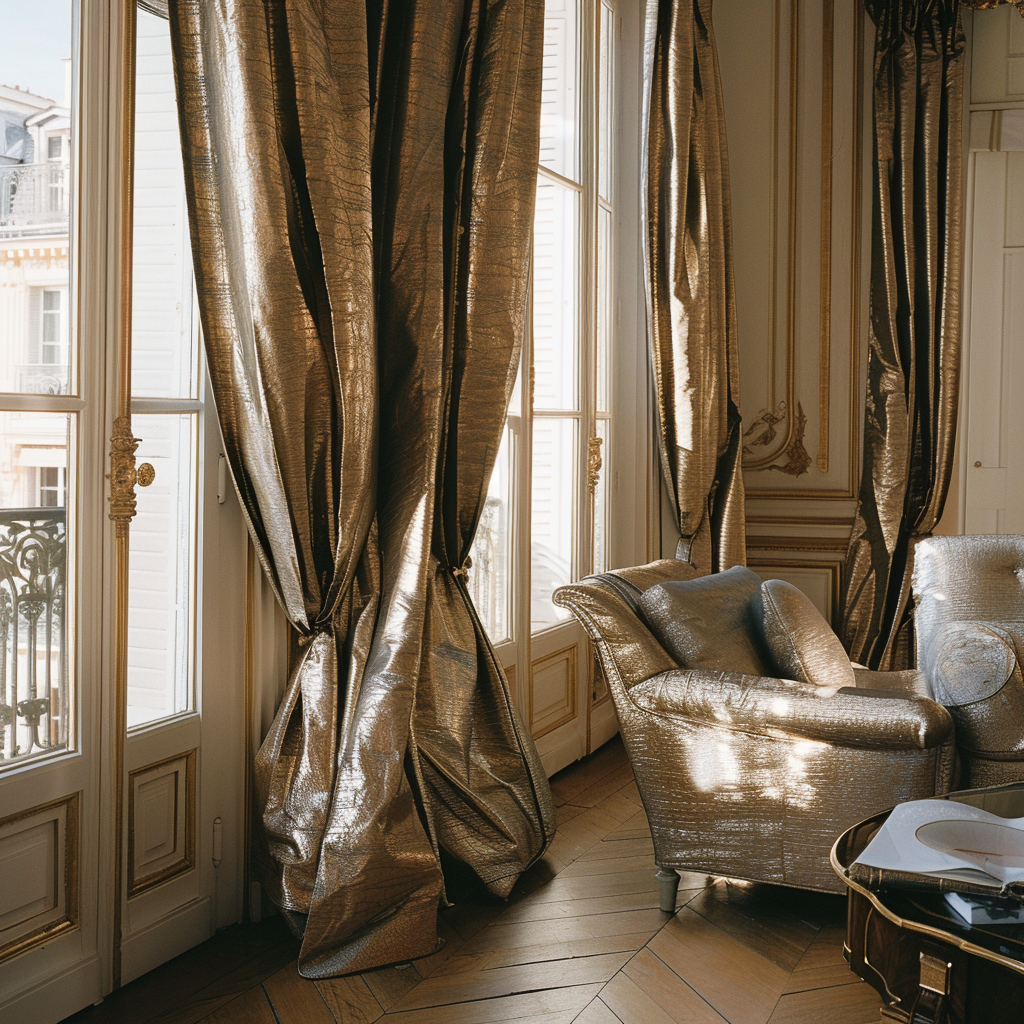
Iridescent curtains with a subtle metallic sheen or iridescence add instant glamor and reflect light beautifully.
Choose metallic curtains in a muted tone like champagne, bronze, silver, pewter or gunmetal rather than a shiny gold fabric which may look overly flashy.
Metallic curtains pair well with both bold jewel tones and muted neutrals.
Here are some ways to incorporate metallic curtains:
- Sequin curtains – Tiny sequins stitched onto sheer fabric provide a shimmery effect when they catch the light.
- Metallic silk – Light refracts off the smooth surface of lustrous metallic silk.
- Jacquard – Intricate jacquard weave incorporates metallic threads for a subtle gleam.
- Lame – Made from metallic fibers wrapped around other threads.
Lightweight with sparkle.
- Fringe trim – Add metallic fringe along curtain edges for a glam accent.
- Embroidery – Metallic silver or gold stitching adds ornate detail.
Hang metallic curtains high and wide to maximize their brilliance.
Draw them back dramatically during the day for full light exposure.
At night, close them to transform the room with an amber glow.
Metallic sheen makes an impressive style statement.
Layered Look

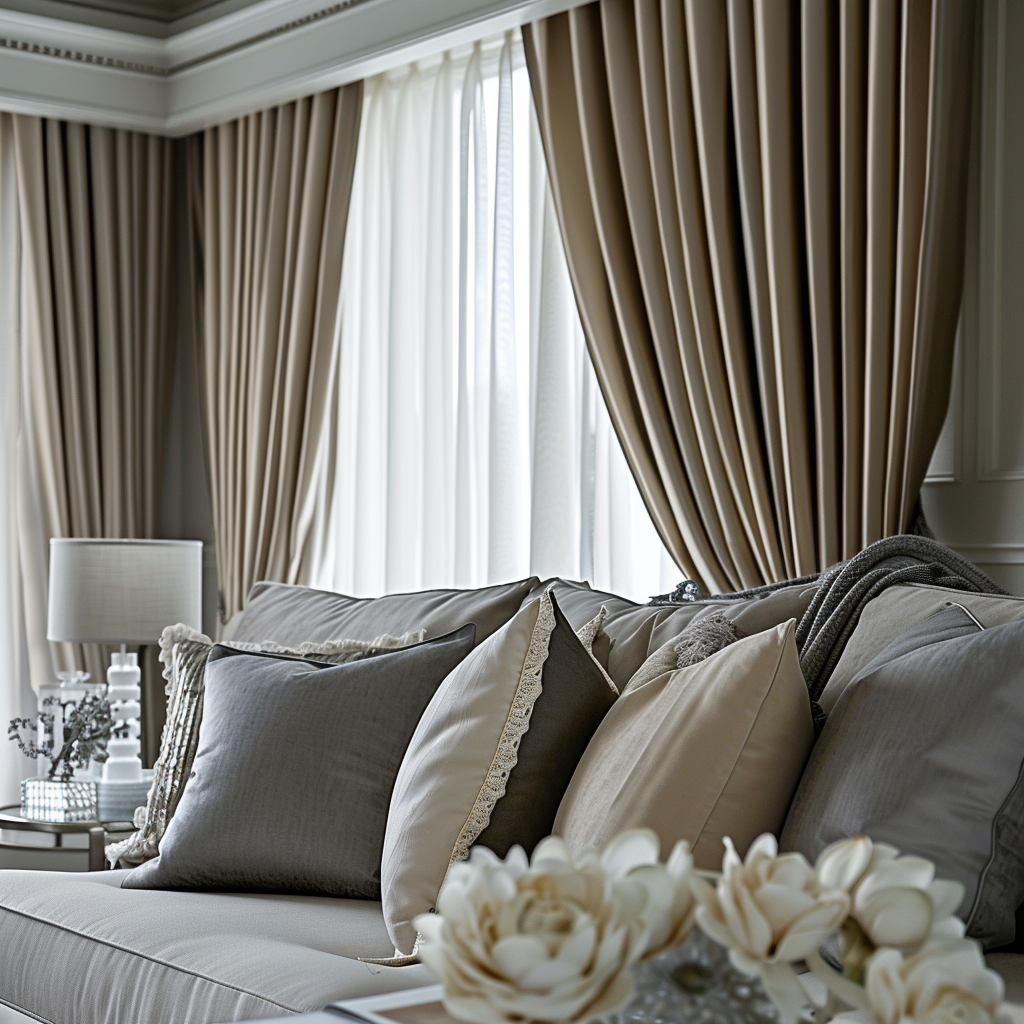
Why choose one curtain when you can have two or three?
The layered curtain look provides visual depth, added privacy, and a custom designer feel.
Start by hanging sheer back panels to filter incoming light softly.
Top the sheers with opaque solid-colored drapes for variable privacy.
Add a third layer of patterned or textured swags or valances along the top window frame.
Follow these guidelines for executing the layered curtain look successfully:
- Hang sheer panels first close to window frames to control incoming light.
Linen or polyester sheers work well.
- Add solid mid-weight opaque curtains on top.
Choose complementary colors that pop against the sheers.
- Top with swags, scarves or fabric valances for a third layer of texture and color.
- Vary textures and patterns for depth.
Contrast sheers with velvet for example.
- Play with proportion.
Floor-length sheers and mid-length solids work nicely.
- Traverse rod systems allow you to layer and adjust curtains easily.
With layers of curtains in varying heights, textures and fullness, your windows will have a custom designer feel.
The light filtration and privacy levels can also be adjusted.
Hanging From Ceiling
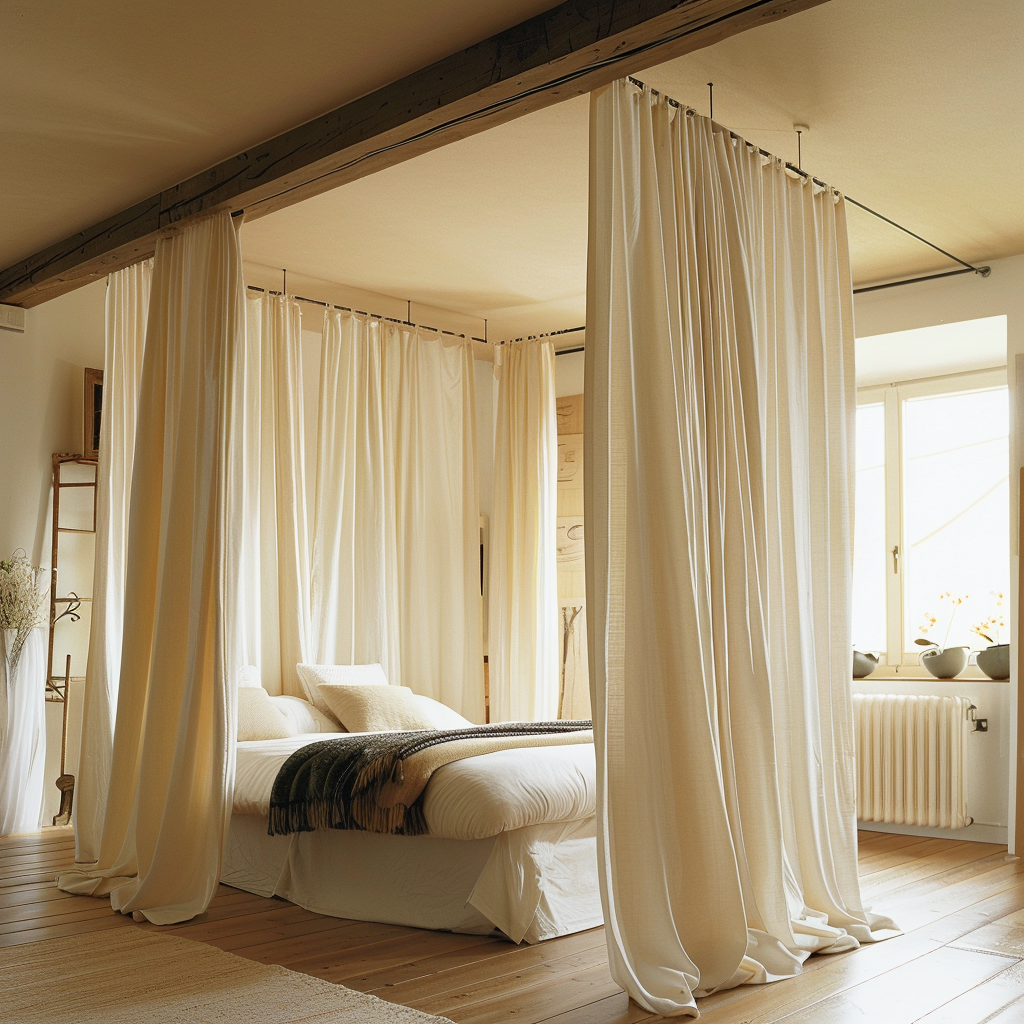
Hanging curtains away from the window frame is an innovative way to draw attention upwards and highlight high ceilings.
Mount a decorative rod or pole on the ceiling above the window rather than attaching it to the wall or window frame.
This technique works best with tall windows in rooms with high ceilings.
Once you have securely mounted ceiling rods, arrange eye-catching curtains that will stand out when suspended from above.
Consider these curtain options:
- Long and flowy – Extra long curtains will pool elegantly on the floor when hung from ceiling.
Silk or velvet are nice choices.
- Bold patterns – Vibrant prints attract the eye upwards.
Florals, geometrics and exotic patterns work well.
- Vivid colors – Saturated curtain colors contrast sharply against neutral walls and ceilings.
- Metallic sheen – Suspended metallic curtains catch and reflect light beautifully.
- Embellished – Ornate details like embroidery, applique and decorative trims stand out from a distance.
The curtains take on the illusion of floating when mounted to ceiling rods.
For even more drama, add cascading swags, tails or contrasting valances at the top.
This innovative window treatment guarantees your windows will get noticed.
✨Click to Get My 101 FREE Designer Room Ideas
Tab Top Curtains
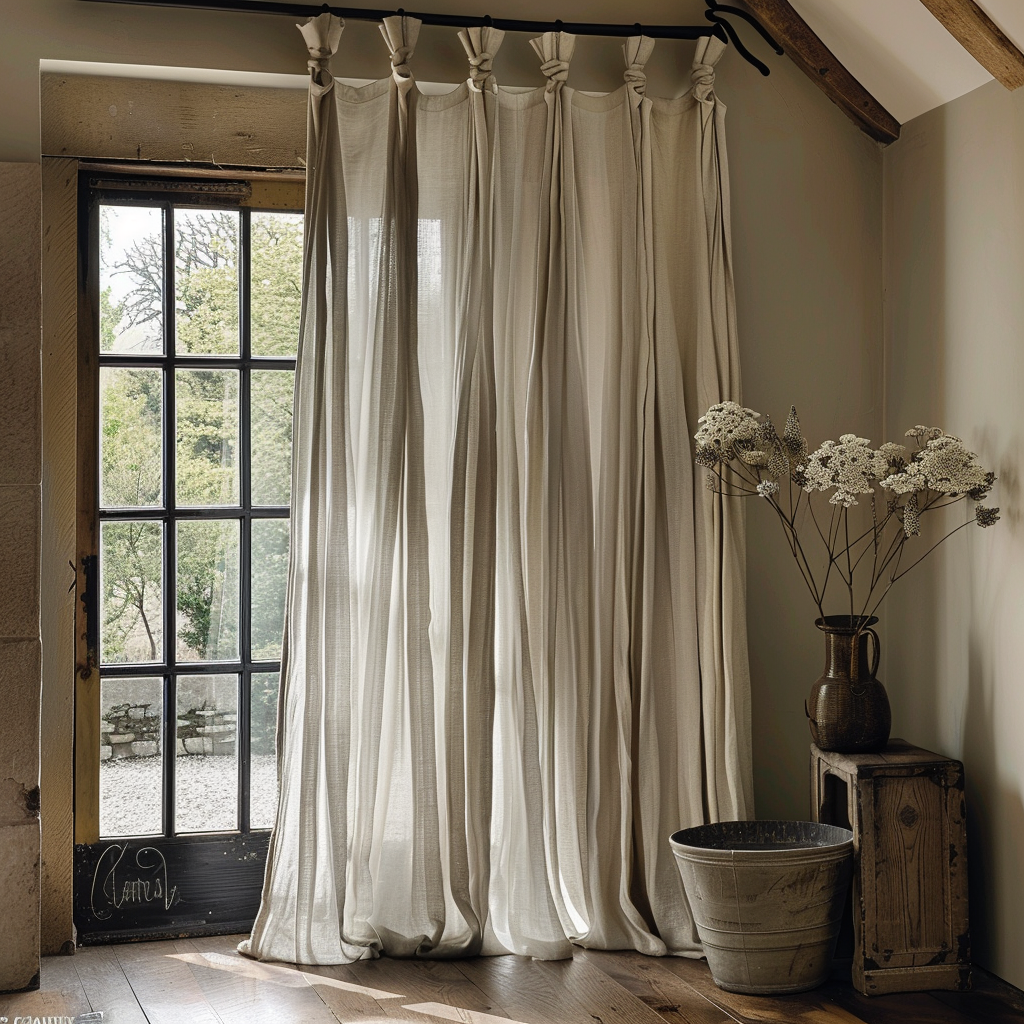
Tab top curtains, also known as cafe-style curtains, are cute and casual.
The defining feature of tab tops is the row of horizontal fabric tabs running along the top edge.
The tabs slide onto curtain rods easily without needing to be sewn.
Tab tops curtains have a relaxed, unfussy style perfect for kitchens, kids’ rooms and casual spaces.
They are also great for rental properties when you want nice window treatments without a permanent installation.
Follow these tips for picking out perfect tab top curtains:
- Fabrics – Cottage-style prints, bright colors, and washable natural fibers work for a casual feel.
- Length – Use short tiers just below the window frame.
For privacy, mid-length curtains ending just below the sill are nice.
- Tabs – Usually 2-3” wide tabs sewn every 6 inches.
The tabs slide right onto rods pocket-free.
- Rods – Thin wooden rods, tension rods or adjustable spring rods work well with tab curtains.
- Toppers – Add a cheerful solid or patterned valance above the tabs for a pulled-together look.
Hang tab top curtains high on your windows without obscuring the view.
Close tabs together at night and spread them open during the day to control incoming light.
The cheerful row of tabs gives windows relaxed personality.
Curtain Pelmets
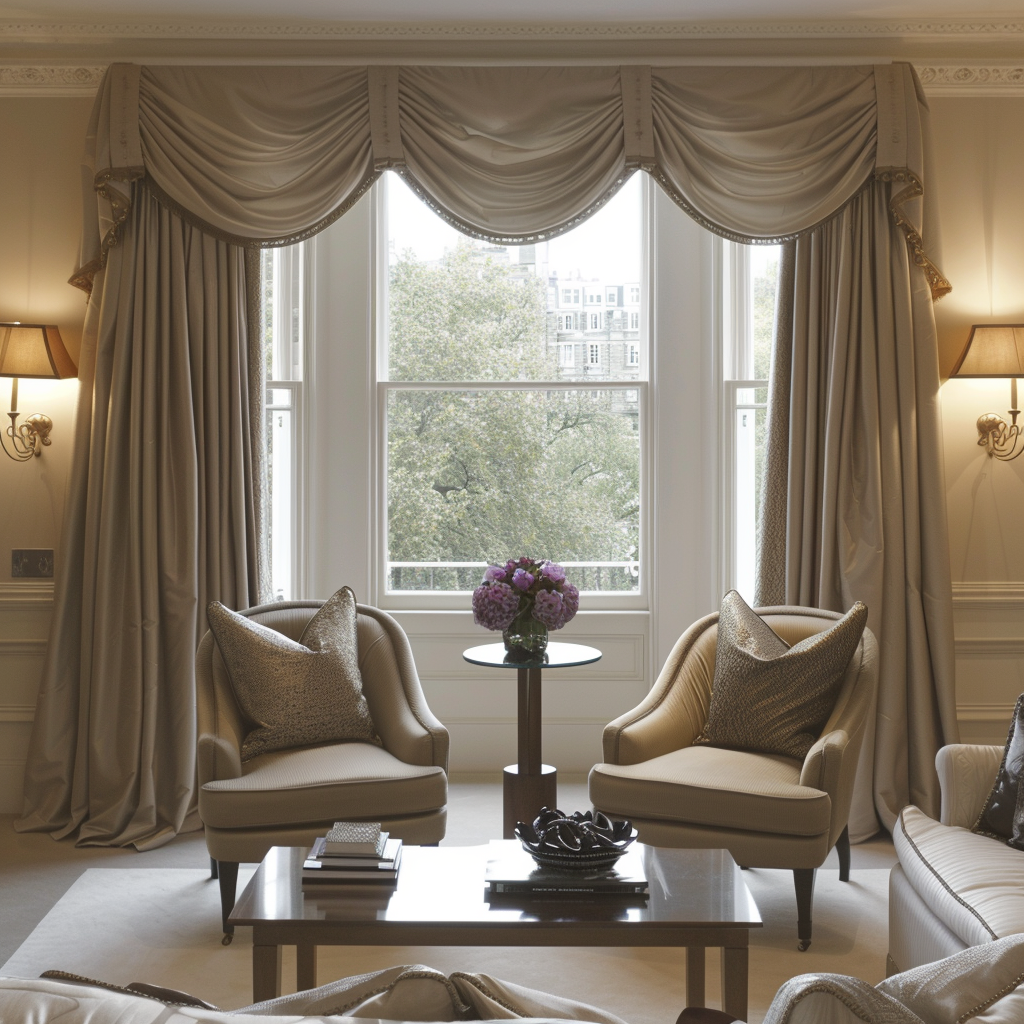
Pelmets are short, decorative fabric canopies that extend out over curtain tops.
They serve to conceal curtain rods and hardware for a streamlined look.
Pelmets also act as an interesting design detail on their own.
Consider these pelmet options:
- Gathered – Soft centered pleats that spread outwards create a flattering silhouette.
- Tailored – A crisp, strongly shaped pelmet for contemporary style.
Stiff interfacing helps it hold shape.
- Shirred – Multiple rows of ruffled fabric form a tiered pelmet that frames curtain tops.
- Box pleated – Sharp knife-edge pleats pointing outwards in symmetrical rows look tailored.
- Padded – Thicker padded pelmets have a luxurious upholstered look.
- Curved – A rounded, arched pelmet complements windows with architectural curves.
Coordinate pelmets with window frames for a harmonious look.
For small windows, a short gathered pelmet provides nice proportions.
Top floor-to-ceiling draperies with a long, linear pelmet for drama.
Pelmets instill a clean polish to curtain treatments.
Tie-back Curtains
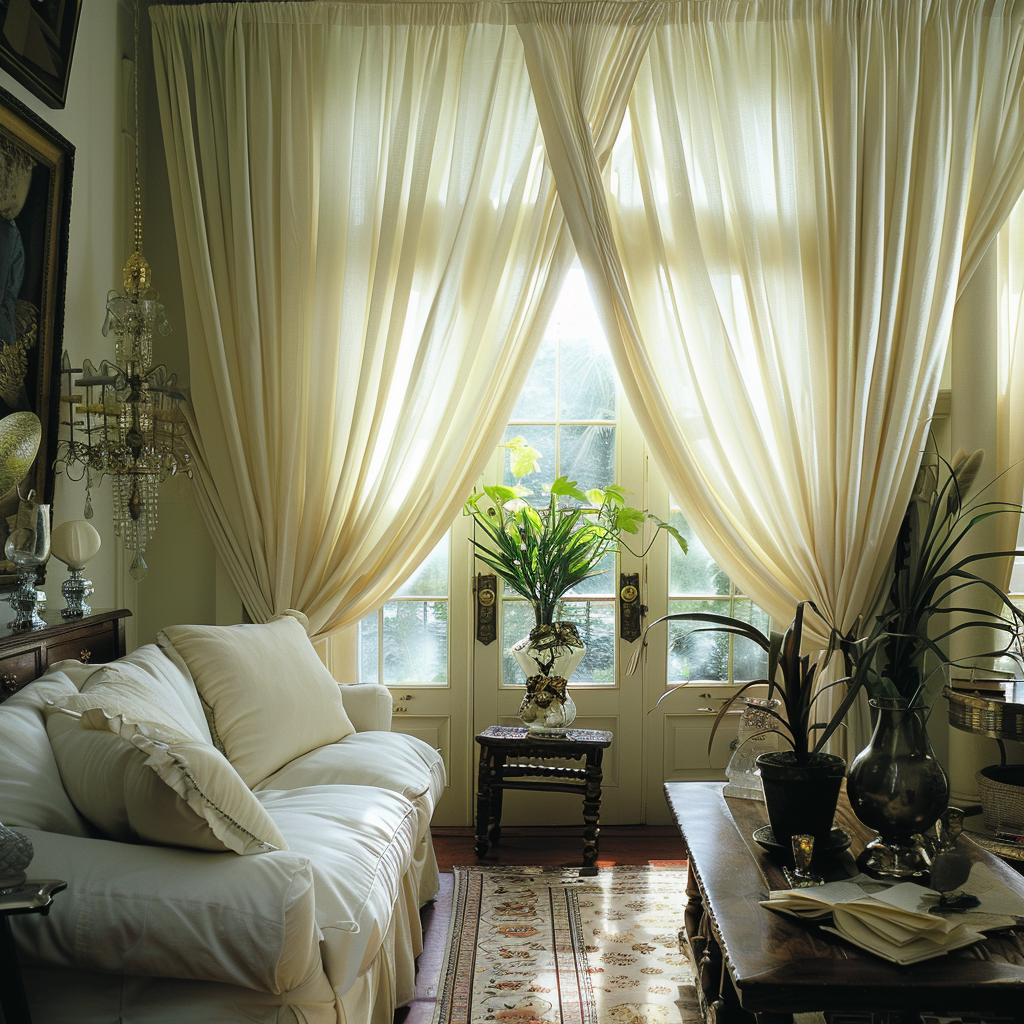
This simple and stylish curtain treatment involves curtains gathered to the side and tied back with decorative cords.
Tie-backs range from understated neutral colors to bright tassels or richly-patterned fabrics that double as art.
Benefits of using pretty tie-backs on your curtains:
- Display curtains while letting in light – Keep them drawn back beautifully during the day.
- Create soft framing around windows – Curtains frame the view beyond with graceful draping.
- Add color, texture and pattern – Tie-backs become part of the decor.
- Adjustable – Change the curtain styling by tying them back in different spots.
- Easy installation – Simply tie back existing curtains or add tie-back hooks to sides of new drapes.
Ideal tie-back styles include gathered poufs, pleated swags, rope ties with tasseled ends, and contrasting bands of patterned fabrics.
Install tie-backs high, midway, or low on the curtains depending on the look you desire.
Elevate ordinary curtains with decorative tie-backs.
Curtain Scarves & Swags

For quick and easy window treatments, drape pretty scarves directly onto curtain rods.
Flowy fabric scarves come in varied patterns, colors and fabrics to complement your decor.
Follow these simple steps for a stylish scarf window treatment:
- Choose scarves about twice the width of your window for fullness.
- Solid colors or subtle prints work better than overly-busy patterns.
- Lightly line sheer scarves for improved opacity.
Fully line opaque fabrics for enhanced draping.
- Arrange scarves in swag, cascade or Gather loosely at ends and drape artfully onto rods.
- Set a high and wide rod position to allow scarves to hang nicely.
- Secure ends with clips or ring hooks if desired.
Scarves need minimal sewing and easily attach to most curtain rods.
Change them out seasonally for an instant refresh.
Floaty fabric scarves lend breezy elegance and color to bare windows inexpensively.
✨Click to Get My 101 FREE Designer Room Ideas
Creative Curtain Rods
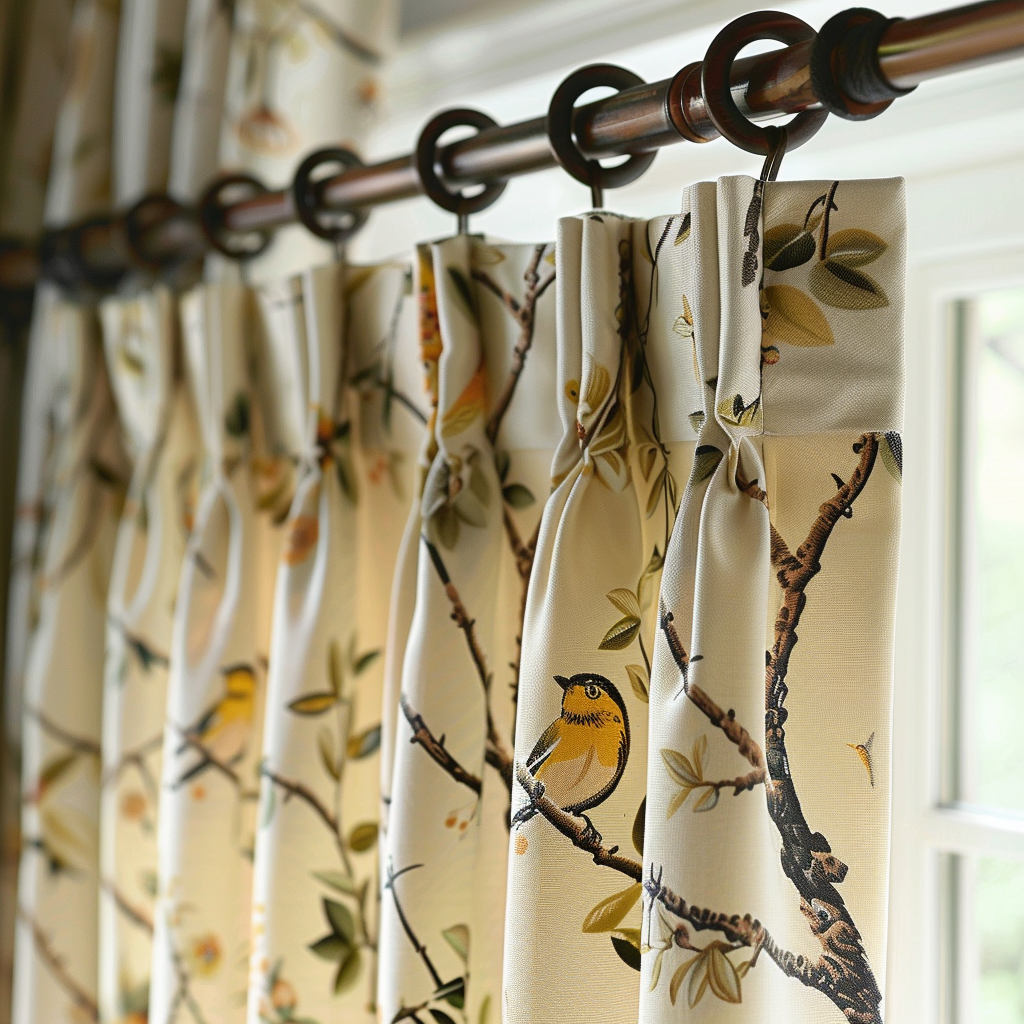
Unique curtain rods and hanging systems offer endlessly creative presentation options.
Explore rod styles like these to make your window treatments stand out:
- Orbital rods – Circular or oval-shaped rods surrounding a window for a dramatic look.
- Double rods – Staggered overlapping rods add depth.
Hang sheers and drapes on separate tracks.
- Floating rods – Tension rods or industrial piping that seems to float in the window frame.
- Finials – Ornate finials on the curtain rod ends become sculptural accents.
- Extendable – Adjustable length rods to fit any window.
Can curve and bend around bay windows.
- Swing-away – Rods that can swing open away from window frames to reveal the entire view.
- Motorized – Electronic rod systems for remote opening and closing of curtains.
Great for large/tall drapes.
Don’t limit yourself to conventional straight rods.
Experiment with circular, zig-zag or unconventionally-hung rods.
Any of these creative hanging systems will get your curtains noticed.
Your curtains present an opportunity to showcase your personal style.
Give your windows personality with statement-making curtains to refresh the look of any room.
With these creative ideas, your windows are sure to stand out as you control light and privacy in style.

